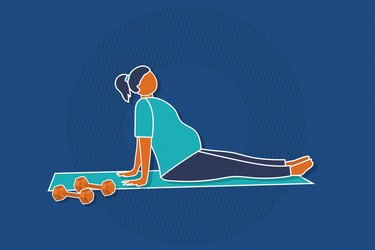
Many of us notice our stomachs don't look the same after having a baby. We may be storing extra fat there, and our bellies may look stretched out and droopy. As such, many of us are looking for tips for shedding belly fat after childbirth.
If you are a breastfeeding or chestfeeding parent, you may want to know if breastfeeding is contributing to this fat storage and if it's safe to lose weight while breastfeeding. You may also be looking for healthy postnatal weight-loss tips and postpartum fitness tips.
Video of the Day
Video of the Day
There are definitely healthy ways to lose belly fat while breastfeeding, and you can do these things without weaning your baby. At the same time, each breastfeeding parent loses weight at different rates, and it's imperative not to compare your postpartum journey with other parents' experiences.
It's also important to cut yourself a lot of slack right now. After all, it took nine months to grow your baby, and it will take some time for your body to get back to normal, or to its "new normal." Self-love and compassion is essential during this time.
Why It Can Be Difficult to Lose Belly Fat While Breastfeeding
You may be wondering: What causes belly fat while breastfeeding, and why is it often so difficult to lose fat around your belly while you're nursing your little one?
The hormones released during breastfeeding may be partly to blame, explains Michael Green, MD, ob-gyn and co-founder at telehealth company Winona. "Losing belly fat while breastfeeding can be difficult due to hormonal changes, particularly the sustained release of prolactin, which promotes fat storage for milk production," he says.
These hormonal changes cause subcutaneous "soft fat" to be stored around your abdomen and hip area, says Carmelita Lombera, RDN, a registered dietitian nutritionist and nutrition consultant for Consumer Health Digest. "Visceral fat is deeper below the skin tissue and lies between the spaces in the abdominal cavity," Lombera adds.
But it's not just breastfeeding that makes it difficult to lose belly fat during breastfeeding. "Most people are left with extra weight after pregnancy, whether they breastfeed or not," says Deedee Franke, RN, IBCLC, a lactation consultant at Mercy Medical Center.
During pregnancy, your body naturally stores fat to prepare for breastfeeding, and the amount you store has to do with your pre-pregnancy weight and pregnancy weight gain, Franke says. "It's natural to take four to six months to lose the weight gained in pregnancy," she explains.
Finally, keep in mind that what makes a postpartum belly look like it's protruding isn't just belly fat, but could be a condition called diastasis recti, which is a separation of the abdominal muscles.
This condition is common among people who've given birth: Up to 60 percent of postpartum people experience it, according to the Cleveland Clinic. It's prevalent among parents who've had both vaginal births and C-section births.
"Diastasis recti happens when significant pressure has been put on the abdominal muscles," explains Bethany Ferguson, RD, IBCLC, a registered dietitian and lactation consultant at Nourishing Babes. "Diastasis recti can literally make you look like you're still pregnant."
For some people, the condition resolves on its own within a few months after childbirth, but about 40 percent of people still have symptoms six months postpartum.
5 Tips to Lose Postpartum Belly Fat
Remember, losing belly fat while breastfeeding is a process and it can take some time, so try to be gentle with yourself. Keep in mind, too, that weight loss while breastfeeding should be done in a way that is healthy for both you and your baby.
Here, experts offer their top tips for losing weight while breastfeeding in a healthy, safe and affirming manner.
1. Focus on Fiber, Protein and Hydration
You will naturally need about 400 extra calories a day while breastfeeding, according to the American College of Obstetricians and Gynecologists (ACOG). If you want to stay healthy while taking in these calories, it's best to prioritize nourishing foods that have a lot of bang for their buck.
"Instead of restricting calories, try to focus on increasing your intake of fiber-rich foods and protein, and get plenty of water," Lombera says.
First, she says to get plenty of protein, aiming for around 70 grams per day, according to November 2016 research in Medical Clinics of North America. Foods high in protein include chicken breast, lentils, salmon and black beans.
For fiber, you can load up on fresh fruits and veggies. "Try enjoying a cup of berries with whipped cream to replace other higher-calorie desserts," Lombera says. "Simple swaps can help you lose belly fat while supporting your body and baby." Aim for around 28 grams a day, according to the FDA.
Many parents will keep a drink in their "nursing station," or wherever they typically nurse their baby, to ensure that they remain properly hydrated throughout the day. Light yellow urine means you're getting enough fluids.
2. Limit Foods High in Added Sugars, Simple Carbs and Saturated Fats
While you prioritize the nourishing foods mentioned above, it can be helpful to limit less nutrient-dense calories, such as those from sugar and refined carbs. Reducing saturated fat may also help support weight loss, Lombera says.
"Your body needs all the macronutrients to produce milk and continue all normal functions," she says, meaning carbs, protein and healthy fats. One way to ensure you're getting plenty of vitamins and other micronutrients to support you is to "focus on including more colorful fruits and vegetables in snacks and meals," Lombera says.
3. Exercise Safely
Many people wonder if it's OK to exercise while breastfeeding. Here's some good news: Not only is exercise safe during breastfeeding, but according to the ACOG, it won't hurt breastfeeding or milk supply. Just make sure you stay hydrated and empty your breasts before exercising to avoid engorgement.
Some safe exercises to consider for your general fitness and to aid in healthy weight loss include walking, swimming, cycling on a stationary bike, strength training and low-impact aerobic training, Lombera says. Make sure you get clearance from your health care provider before beginning postpartum exercise, Dr. Green adds.
Most of the time, you can resume light exercises soon after birth, according to the ACOG, provided you've had an uncomplicated vaginal delivery. People who had C-sections or complicated deliveries may need to wait longer.
4. Consider Pelvic Floor Therapy
If you've been diagnosed with diastasis recti and it doesn't seem to be resolving on its own, you may want to meet with a pelvic floor physical therapist so you can learn simple exercises to help close the gap. Treating diastasis recti technically won't help you lose weight, but it may help flatten your belly.
"If a postpartum parent is concerned about the muscle separation of the abdomen, they should consult their health care provider for evaluation of the separation and seek a physical therapy consultation to learn the proper exercises to improve this condition as well avoid activities which can worsen the separation," Franke says.
5. Meet With a Dietitian
Your nutritional needs change after pregnancy and during breastfeeding, and if you're confused about eating in a healthy way to lose weight, you may want to consider get some professional help from a registered dietitian.
Look for a dietitian with experience working with people in the postpartum period, Franke says. Together, you'll come up with an individualized eating plan that takes your dietary preferences and lifestyle into consideration.
Managing Your Expectations
It's vital to be patient during your postpartum journey and to set realistic goals and expectations when it comes to weight loss — but this can be a challenge.
“It's hard to have realistic expectations about ourselves because of social media and such a 'thin ideal' surrounding us all the time,” Ferguson says. “The best thing you can do is to have grace with yourself. Know that your body is strong because it created life and it is supporting two beings now by keeping you and your baby alive and nourished.”
As much as you can, prioritize self-care during this time. It can take some trial and error to determine what works best for you when it comes to honoring and respecting your body, Ferguson says, but it might look like going for a walk while someone holds your baby, nourishing your body with nutrient-rich food or buying clothes that fit your current body comfortably, she says.
3 Things to Avoid
While there are many healthy ways to lose unwanted weight while breastfeeding, there are some strategies that you should steer clear of.
1. Drastically Cutting Calories
Avoid eating plans that are severe or drastic, Dr. Green says. "I would never recommend that any pregnant or postpartum parents take on extreme diet practices," he says. For example, low-calorie diets can compromise nutrient intake and make breastfeeding harder, he says.
Keep in mind diets that promise quick weight loss "are usually too good to be true," he adds. "Gradual, steady weight loss is safer and more sustainable than rapid methods."
2. Taking Weight-Loss Medications
Dr. Green also advises strongly against using any type of weight-loss medications while breastfeeding. "Weight-loss medications have not been studied extensively for safety during breastfeeding and should be avoided," he says.
3. Exercising Too Intensely
While light exercise is fine and recommended once you have clearance from your doctor, high-impact, strenuous exercise is off the table at first, Dr. Green says. Going too hard too soon can "strain weakened postpartum muscles," he says. Instead, build up the intensity "gradually and patiently," he says.
The Bottom Line
It's completely understandable to have complicated feelings about your changing body after pregnancy and while breastfeeding, including about your belly.
It's also OK to want to try to get rid of your postpartum belly. You are not the only one who feels this way. But it's also crucial to keep in mind that while there are ways to lose belly fat in a safe way while breastfeeding, it can take some time. Ultimately, the goal should be to adopt healthy habits that work best for you and your family, not simply change what you see in the mirror.
- ACOG: "Breastfeeding Your Baby"
- ACOG: "Exercise After Pregnancy"
- ACOG: "Physical Activity and Exercise During Pregnancy and the Postpartum Period"
- Cleveland Clinic: "Diastasis Recti"
- Medical Clinics of North America: "Nutrition Recommendations in Pregnancy and Lactation"
- FDA: "Frequently Asked Questions for Industry on Nutrition Facts Labeling Requirements"
Was this article helpful?
150 Characters Max
0/150
Thank you for sharing!
Thank you for your feedback!


